Lecture notes written by Albert Jacka
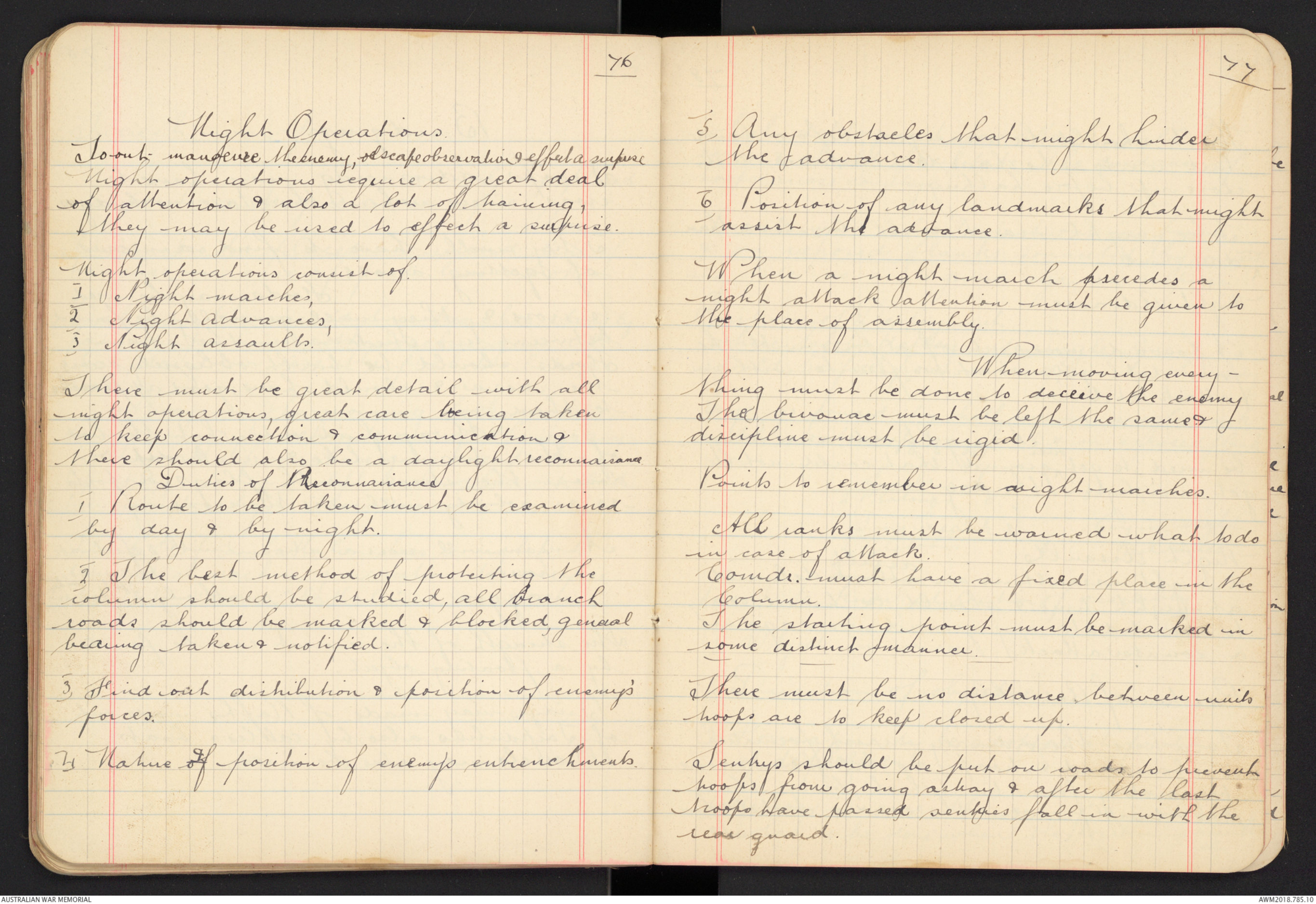
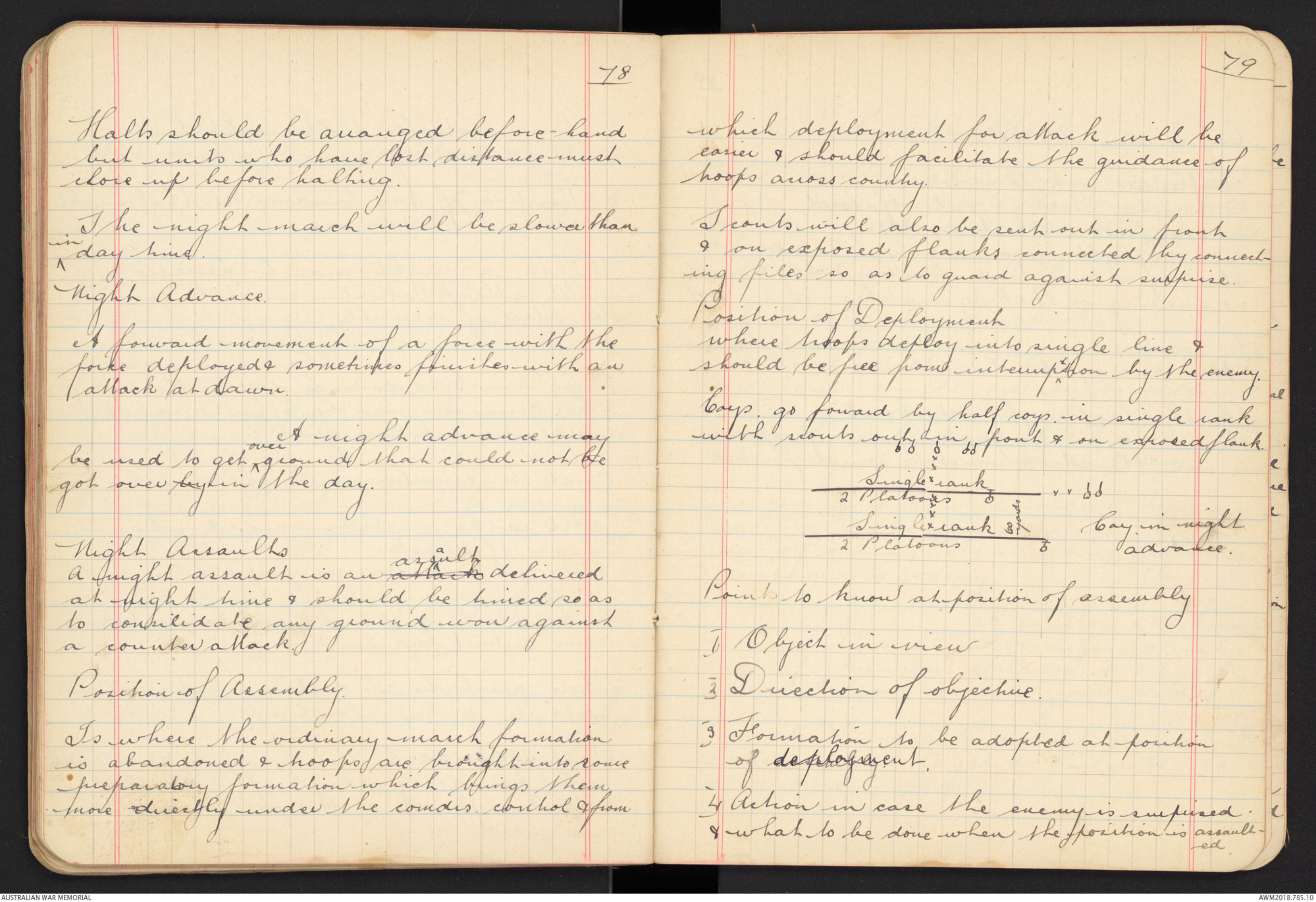
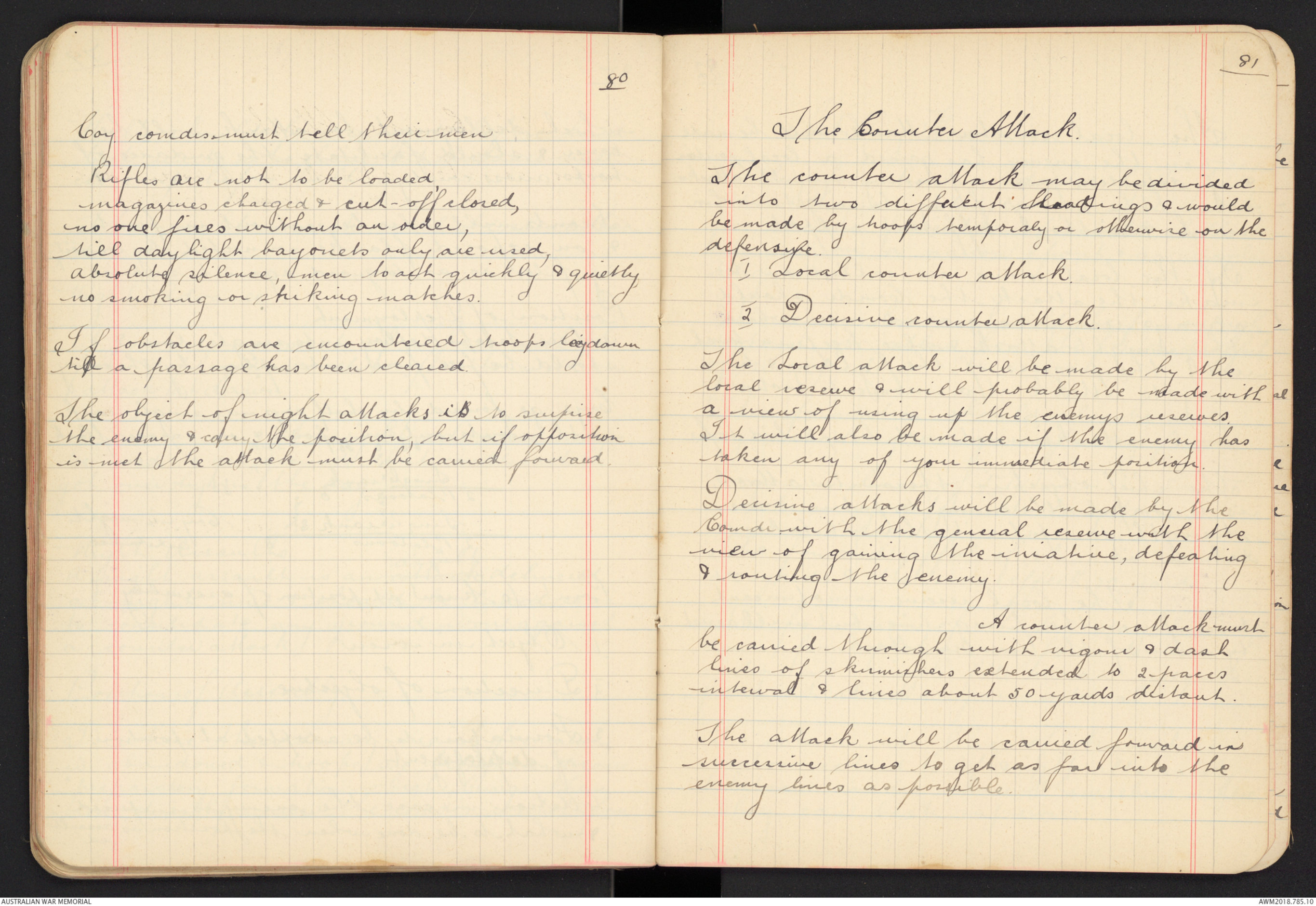
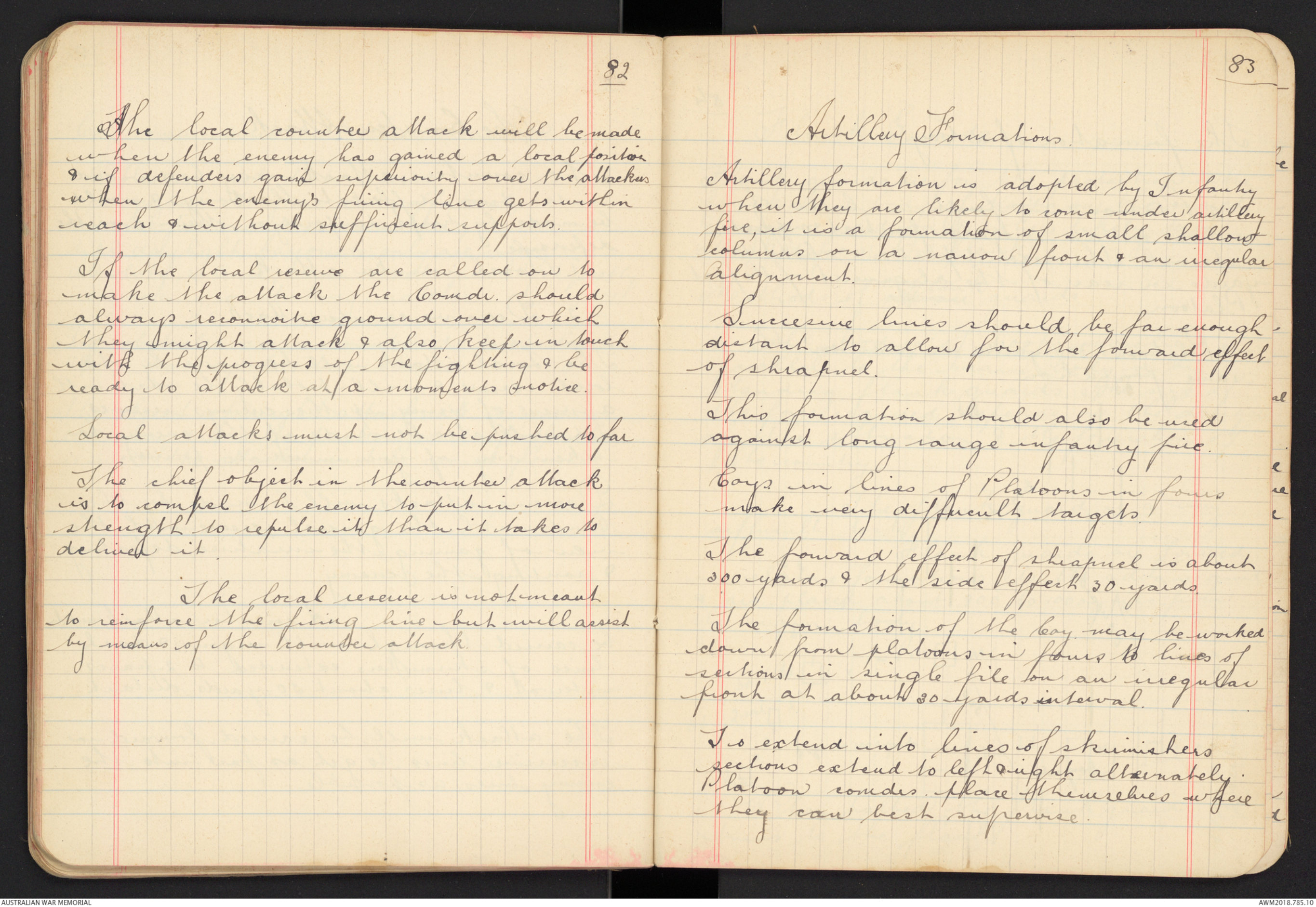
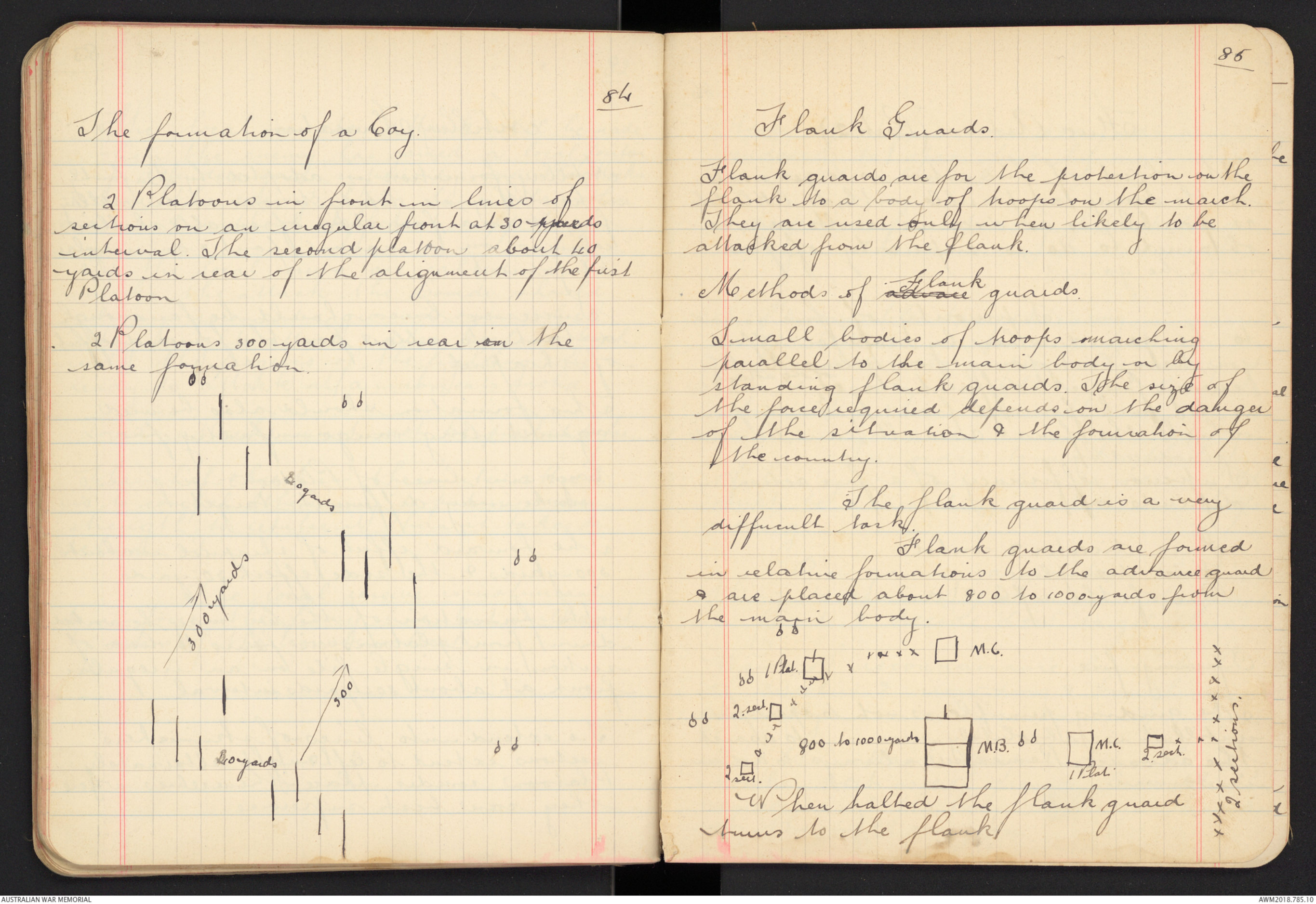
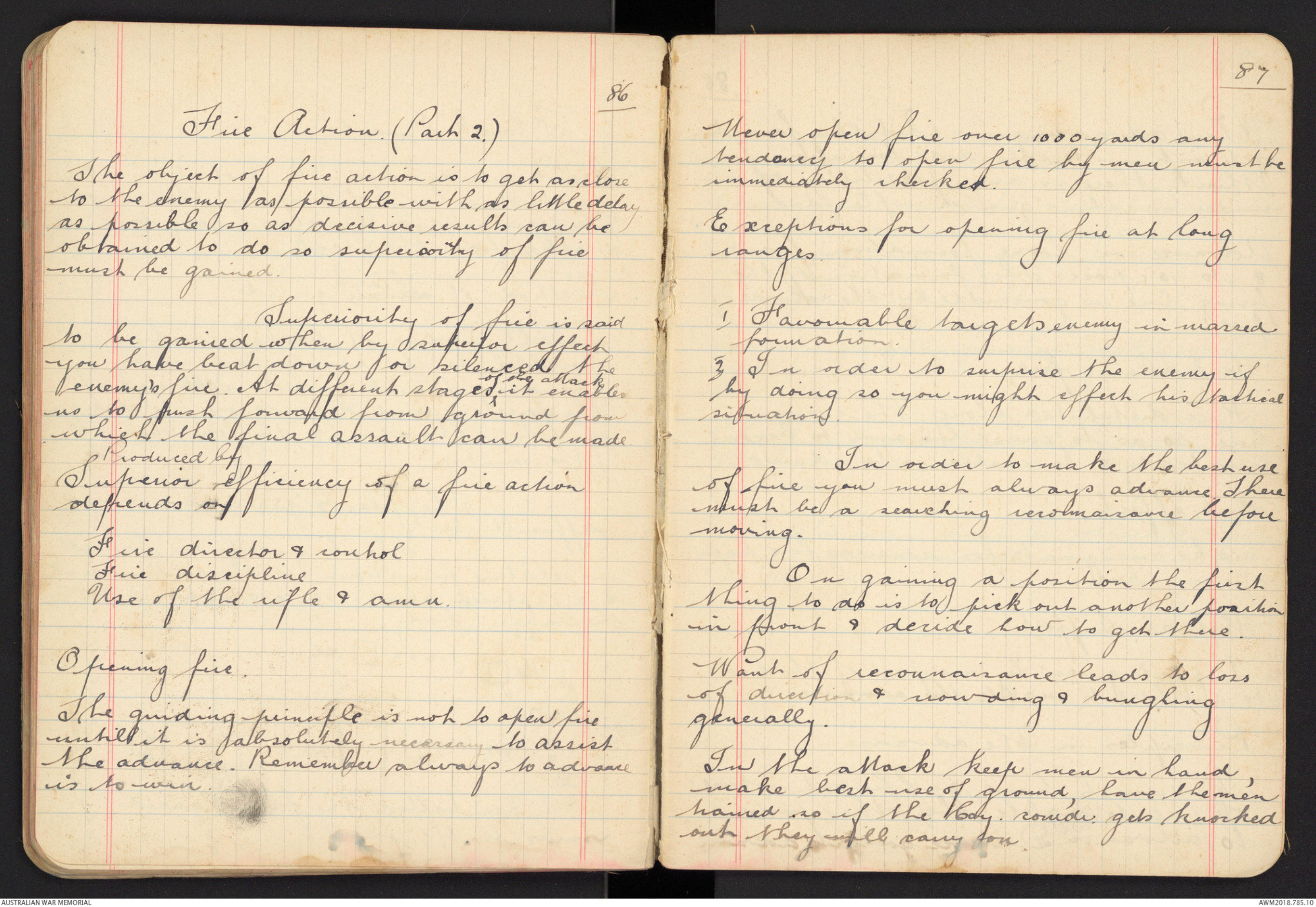
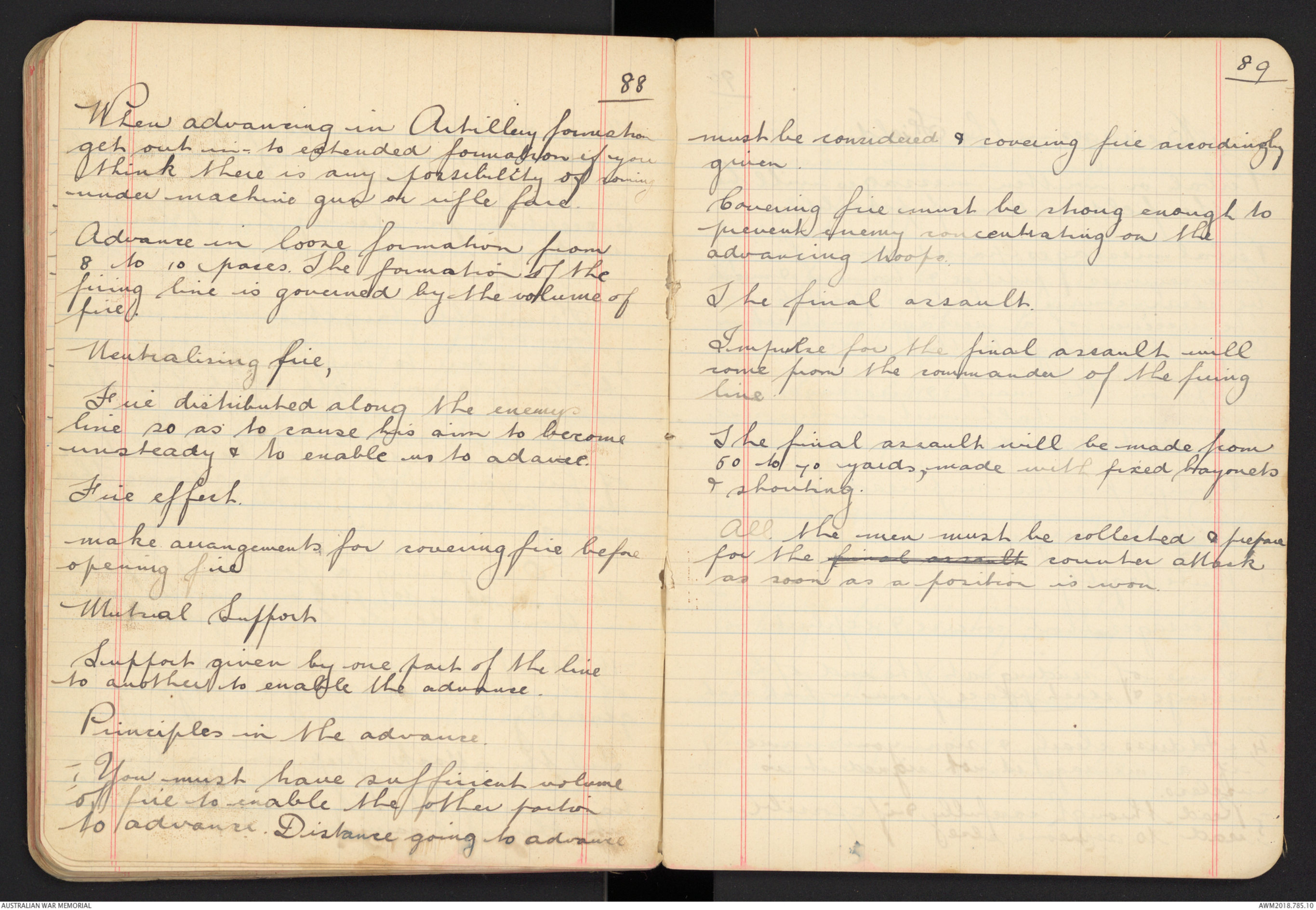
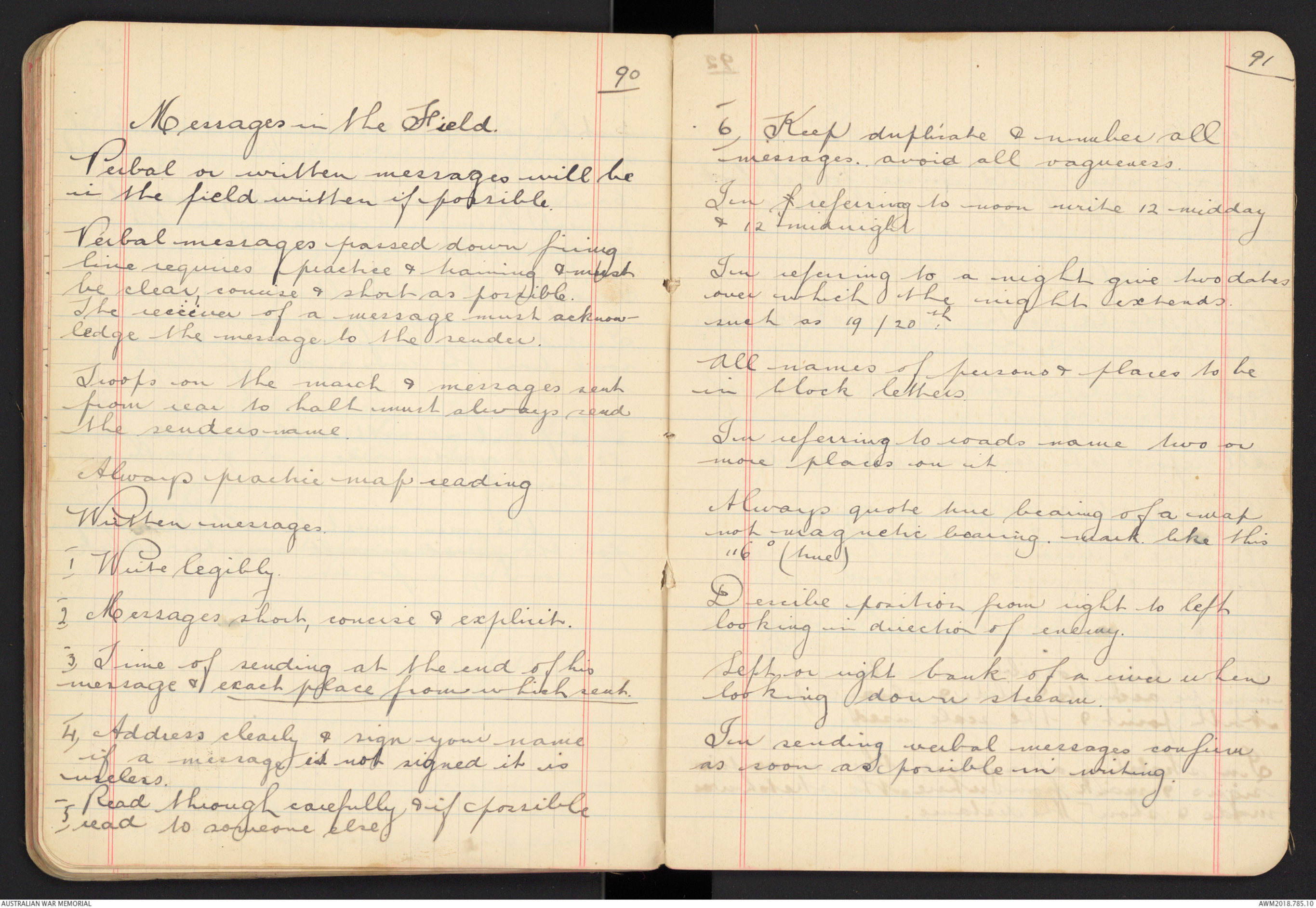
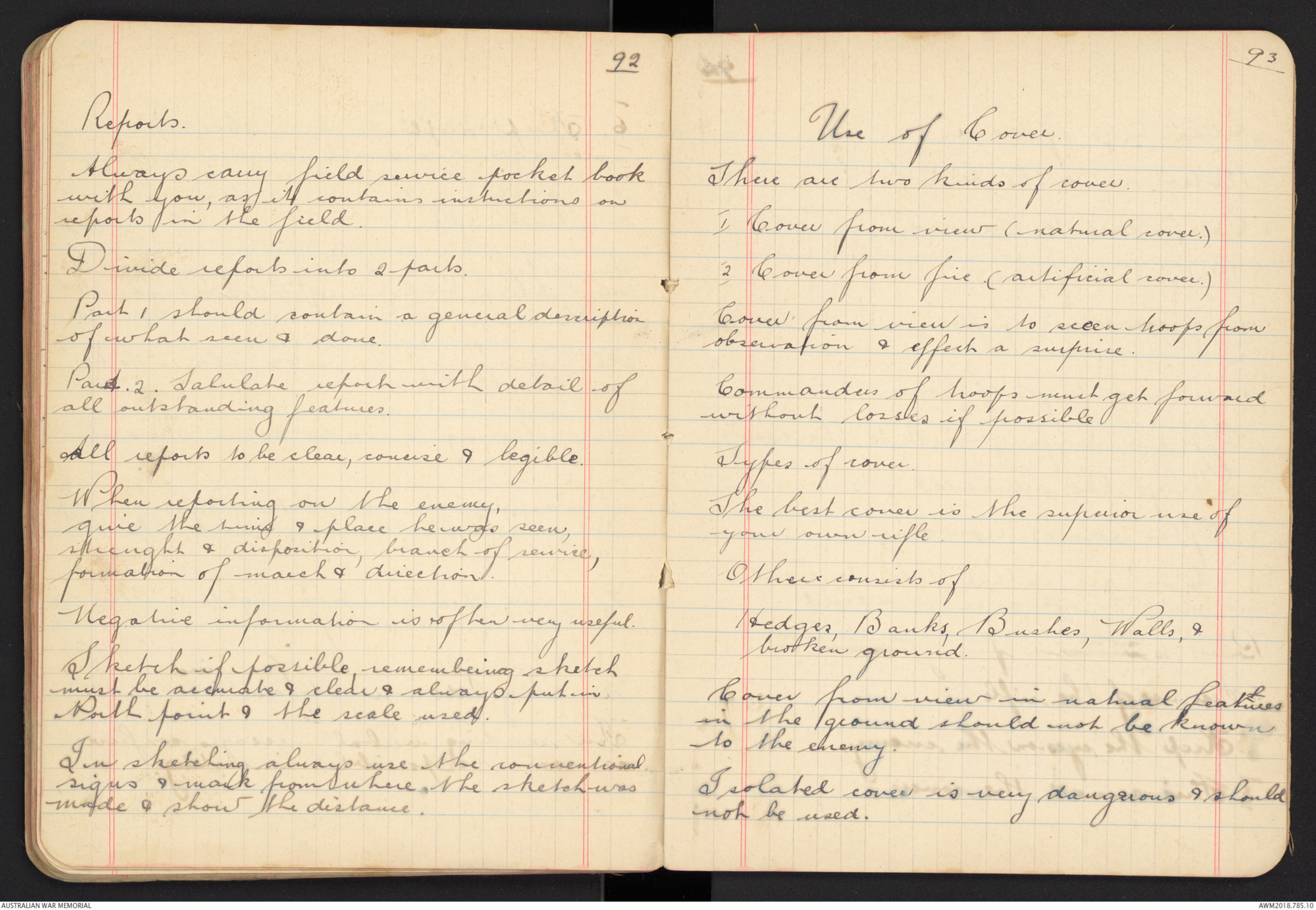
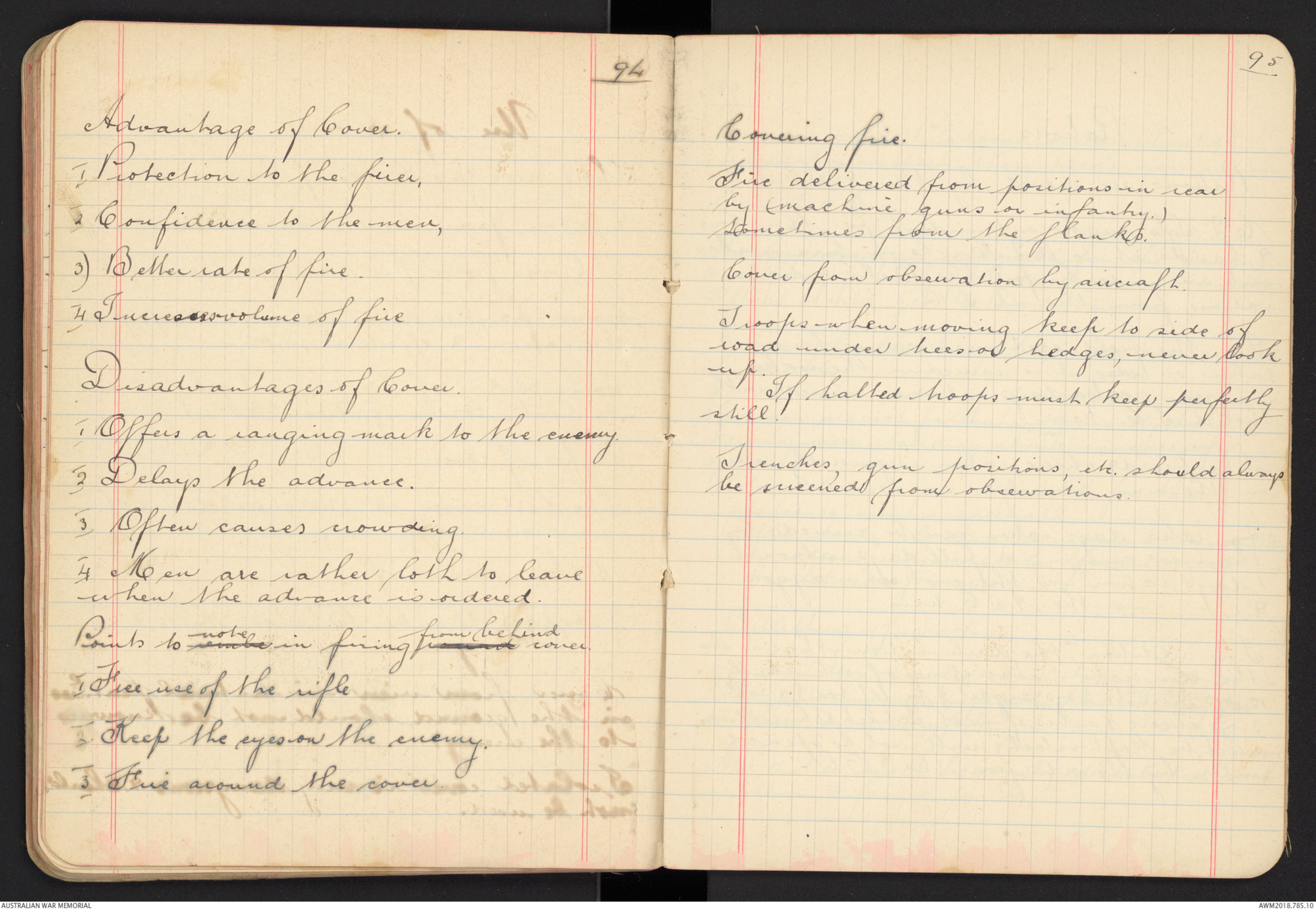
76
Night Operations
To out manoevre the enemy, oescape observation & effect a surprise
Night operations require a great deal
of attention & also a lot of training,
they may be used to effect a surprise.
Night operations consist of.
(1) Night marches,
(2) Night advances,
(3) Night assaults.
There must be great detail with all
night operations, great care being taken
to keep connection & communication &
there should also be a daylight reconnaisance.
Duties of Reconnaisance.
(1) Route to be taken must be examined
by day & by night.
(2) The best method of protecting the
column should be studied, all branch
roads should be marked & blocked, general
bearing taken & notified.
(3) Find out distribution & position of enemy's
forces.
(4) Nature of & position of enemy's entrenchments.
77
(5) Any obstacles that might hinder
the advance.
(6) Position of any landmarks that might
assist the advance.
When a night march precedes a
night attack attention must be given to
the place of assembly.
When moving everything
must be done to deceive the enemy
The bivouac must be left the same &
discipline must be rigid.
Points to remember in night marches.
All ranks must be warned what to do
in case of attack.
Comdr. must have a fixed place in the
Column.
The starting point must be marked in
some distinct manner.
There must be no distance between units
troops are to keep closed up.
Sentrys should be put on roads to prevent
troops from going astray & after the last
troops have passed sentries fall in with the
rear guard.
78
Halts should be arranged before-hand
but units who have lost distance must
close up before halting.
The night march will be slower than
^in day time.
Night Advance.
A forward movement of a force with the
force deployed & sometimes finishes with an
attack at dawn.
A night advance may
be used to get ^over ground that could not be
got over by in the day.
Night Assaults
A night assault is an attack ass^ault delivered
at night time & should be timed so as
to consolidate any ground won against
a counter attack.
Position of Assembly.
Is where the ordinary march formation
is abandoned & troops are brought into some
preparatory formation which brings them
more directly under the comdrs. control & from
79
which deployment for attack will be
easier & should facilitate the guidance of
troops across country.
Scouts will also be sent out in front
& on exposed flanks connected by connecting
files so as to guard against surprise.
Position of Deployment
Where troops deploy into single line &
should be free from interrup^tion by the enemy.
Coys. go foward by half coys in single rank
with scouts out in front & on exposed flank.
Diagram - see original document
Points to know at position of assembly
(1) Object in view
(2) Direction of objective.
(3) Formation to be adopted at position
of deployment.
(4) Action in case the enemy is surprised
& what to be done when the position is assaulted.
80
Coy. comdrs must tell their men
Rifles are not to be loaded,
magazines charged & cut-off closed,
no one fires without an order,
till daylight bayonets only are used,
absolute silence, men to act quickly & quietly,
no smoking or striking matches.
If obstacles are encountered troops lie down
till a passage has been cleared.
The object of night attacks is to surprise
the enemy & carry the position, but if opposition
is met the attack must be carried forward.
81
The Counter Attack.
The counter attack may be divided
into two different headings & would
be made by troops temporaly or otherwise on the
defensive.
(1) Local counter attack.
(2) Decisive counter attack.
The Local attack will be made by the
local reserve & will probably be made with
a view of using up the enemys reserves.
It will also be made if the enemy has
taken any of your immediate position.
Decisive attacks will be made by the
Comdr with the general reserve with the
view of gaining the iniative, defeating
& routing the enemy.
A counter attack must
be carried through with vigour & dash
lines of skirmishers extended to 2 paces
interval & lines about 50 yards distant.
The attack will be carried forward in
successive lines to get as far into the
enemy lines as possible.
82
The local counter attack will be made
when the enemy has gained a local position
& if defenders gain superiority over the attackers
when the enemy's firing line gets within
reach & without sufficent supports.
If the local reserve are called on to
make the attack the Comdr. should
always reconnoitre ground over which
they might attack & also keep in touch
with the progress of the fighting & be
ready to attack at a moments notice.
Local attacks must not be pushed to far
The chief object in the counter attack
is to compel the enemy to put in more
strength to repulse it than it takes to
deliver it.
The local reserve is not meant
to reinforce the firing line but will assist
by means of the counter attack
83
Artillery Formations.
Artillery formation is adopted by Infantry
when they are likely to come under artillery
fire, it is a formation of small shallow
columns on a narrow front & an irregular
alignment.
Succesive lines should be far enough
distant to allow for the forward effect
of shrapnel.
This formation should also be used
against long range infantry fire.
Coys. in lines of Platoons in fours
make very difficult targets.
The forward effect of shrapnel is about
300 yards & the side effect 30 yards.
The formation of the Coy. may be worked
down from platoons in fours to lines of
sections in single file on an irregular
front at about 30 yards interval.
To extend into lines of skirmishers
sections extend to left & right alternately.
Platoon comdrs. place themselves where
they can best supervise.
84
The formation of a Coy.
2 Platoons in front in lines of
sections on an irregular front at 30 yards
interval. The second platoon about 40
yards in rear of the alignment of the first
Platoon
2 Platoons 500 yards in rear in the
same formation.
Diagram - see original document
85
Flank Guards.
Flank guards are for the protection on the
flank to a body of troops on the march.
They are used only when likely to be
attacked from the flank.
Methods of advance Flank guards.
Small bodies of troops marching
parallel to the main body or by
standing flank guards. The size of
the force required depends on the danger
of the situation & the formation of
the country.
The flank guard is a very
difficult task.
Flank guards are formed
in relative formations to the advance guard
& are placed about 800 to 1000 yards from
the main body.
Diagram - see original document
When halted the flank guard
tums to the flank.
86
Fire Action. (Part 2.)
The object of fire action is to get as close
to the enemy as possible with as little delay
as possible so as decisive results can be
obtained to do so superiority of fire
must be gained.
Superiority of fire is said
to be gained when by superior effect
you have beat down or silenced the
enemy's fire. At different stages ^of the attack it enables
us to push forward from ground from
which the final assault can be made.
Produced by
Superior efficiency of a fire action
depends on
Fire director & control
Fire discipline
Use of the rifle & amn.
Opening fire.
The guiding principle is not to open fire
until it is absolutely necessary to assist
the advance. Remember always to advance
is to win.
87
Never open fire over 1000 yards any
tendency to open fire by men must by
immediately checked.
Exceptions for opening fire at long
ranges.
(1) Favourable targets enemy in massed
formation.
(2) In order to surprise the enemy if
by doing so you might effect his tactical
situation.
In order to make the best use
of fire you must always advance. There
must be a searching reconnaissance before
moving.
On gaining a position the first
thing to do is to pick out another position
in front & decide how to get there.
Want of reconnaissance leads to loss
of direction & crowding & bungling
generally.
In the attack keep men in hand,
make best use of ground, have the men
trained so if the Coy, comdr. gets knocked
out they will carry on.
88
When advancing in Artillery formation
get out in-to extended formation if you
think there is any possibility of coming
under machine gun or rifle fire.
Advance in loose formation from
8 to 10 paces. The formation of the
firing line is governed by the volume of
fire.
Neutralising fire,
Fire distributed along the enemy
line so as to cause his aim to become
unsteady & to enable us to advance.
Fire effect.
make arrangements for covering fire before
opening fire
Mutual Support
Support given by one part of the line
to another to enable the advance.
Principles in the advance.
(1) You must have sufficient volume
of fire to enable the other portion
to advance. Distance going to advance
89
must be considered & covering fire accordingly
given.
Covering fire must be strong enough to
prevent enemy concentrating on the
advancing troops.
The final assault.
Impulse for the final assault will
come from the commander of the firing
line.
The final assault will be made from
50 to 70 yards, made with fixed bayonets
& shouting.
All the men must be collected & prepared
for the final assault counter attack
as soon as a position is won.
90
Messages in the Field.
Verbal or written messages will be
in the field written if possible.
Verbal messages passed down firing
line requires practice & training & must
be clear, concise & short as possible.
The receiver of a message must acknowledge
the message to the sender.
Troops on the march & messages sent
from rear to halt must always send
the senders name.
Always practice map reading.
Written messages.
(1) Write legibly.
(2) Messages short, concise & explicit.
(3) Time of sending at the end of his
message & exact place from which sent.
(4) Address clearly & sign your name
if a message is not signed it is
useless.
(5) Read through carefully & if possible
read to someone else.
91
6 Keep duplicate & number all
messages, avoid all vagueness.
In f referring to noon write 12 middday
& 12 midnight
In referring to a night give two dates
over which the night extends
such as 19//20th.
All names of persons & places to be
in block letters.
In referring to roads name two or
more places on it.
Always quote true bearing of a map
not magnetic bearing. mark like this
116o (true)
Describe position from right to left
looking in direction of enemy.
Left or right bank of a river when
looking down stream.
In sending verbal messages confirm
as soon as possible in writing.
92
Reports.
Always carry field service pocket book
with you, as it contains instructions on
reports in the field.
Divide reports into 2 parts.
Part 1 should contain a general description
of what seen & done.
Part. 2. Tabulate report with detail
all outstanding features.
All reports to be clear, concise & legible.
When reporting on the enemy,
give the time & place he was seen,
strength & disposition, branch of service,
formation of march & direction.
Negative information is often very useful.
Sketch if possible, remembering sketch
must be accurate & clear & always put in
North point & the scale used.
In sketching always use the conventional
signs & mark from where the sketch was
made & show the distance.
93
Use of Cover
There are two kinds of cover.
(1) Cover from view (natural cover.)
(2) Cover from fire (artificial cover.)
Cover from view is to sceen troops from
observation & effect a surprise.
Commanders of troops must get forward
without losses if possible
Types of cover.
The best cover is the superior use of
your own rifle.
Others consists of
Hedges, Banks, Bushes, Walls &
broken ground.
Cover from view in natural features
in the ground should not be known
to the enemy.
Isolated cover is very dangerous & should
not be used.
94
Advantage of Cover.
(1) Protection to the firer,
(2) Confidence to the men,
(3) Better rate of fire.
(4) Increases volume of fire
Disadvantages of Cover.
(1) Offers a ranging mark to the enemy
(2) Delays the advance.
(3) Often causes crowding.
(4) Men are rather loth to leave
when the advance is ordered.
Points to remember note in firing under from behind cover.
(1) Free use of the rifle
(2) Keep the eyes on the enemy
(3) Fire around the cover.
95
Covering fire.
Fire delivered from positions in rear
by (machine, guns or infantry.)
Sometimes from the flanks.
Cover from observation by aircraft.
Troops when moving keep to side
road under trees or hedges, never look
up.
If halted troops must keep perfectly
still.
Trenches, gun positions, etc. should always
be screened from observations.
 Sam scott
Sam scottThis transcription item is now locked to you for editing. To release the lock either Save your changes or Cancel.
This lock will be automatically released after 60 minutes of inactivity.